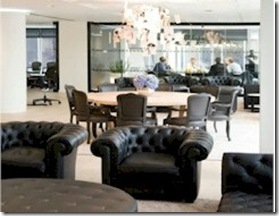An essential component to Dynamic Work is applying the principles of dynamism to the workplace itself. Much as there is too much wasted office space (lit, powered, air conditions, secured) and time in centralised offices, ‘the office’ can and does play an important role in professional productivity.
A little while ago I had the privilege of a tour of Edelman’s offices by their UK chief executive Robert Phillips. Edelman is one of Microsoft’s PR agencies who run a number of campaigns including citizenship and top level vision.
The stereotype is that fancy-shmancy innovative digs are the preserve of well-to-do companies with money to burn on such niceties. The reality of the situation is that despite the couches, the artwork, the chandelier, the leather couches, the bar, the artwork, etc., the ‘fit out’ cost of the space is in the lowest quartile of expense for London offices. A dirty little secret to office space expense is that cubicles and standardised office fittings destroy the wallet as much as the soul.
The FT has done a great overview of the workspace in the article ‘No space wasted in in the Velcro workplace of the future’:
“Breaking down barriers between staff, too, was a primary aim when Edelman HQ combined with two subsidiary agencies in the new office in June. Mr Phillips says the results are already showing through. ‘Our win rate on cross-practice pitches has gone up by 30-40 per cent in four months because people haven't sat in silos,’ he says…Each part of Edelman's office, which was created by Gensler, the international architecture and interior design firm, is multifunctional. This accords with Gensler's model of four 21st-century work modes. Only one of these – head-down, focused work – is solitary. The others – collaborating on tasks, learning skills, and socialising for work purposes – involve interaction.”
Other details are included in the following references: Case study article and a Presentation overview on project by design firm Gensler.

